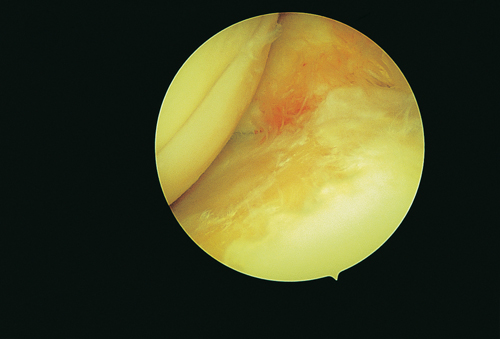Difference between revisions of "Equine Orthopaedics and Rheumatology Q&A 10"
Jump to navigation
Jump to search
Ggaitskell (talk | contribs) (Created page with "{{Template:Manson May}} centre|500px<br> <br /> <br /> <FlashCard questions="4"> |q1=What is your diagnosis? |a1=A ...") |
Ggaitskell (talk | contribs) |
||
| Line 1: | Line 1: | ||
{{Template:Manson May}} | {{Template:Manson May}} | ||
| − | [[Image:Equine Orthopaedics and Rheumatology Q&A | + | [[Image:Equine Orthopaedics and Rheumatology Q&A 10.jpg|centre|500px]]<br> |
<br /> | <br /> | ||
| + | '''A 10-year old Quarterhorse roping gelding presented for sudden onset lameness of the left forelimb. An arthroscopic view of the left midcarpal joint is illustrated.''' | ||
<br /> | <br /> | ||
<FlashCard questions="4"> | <FlashCard questions="4"> | ||
| − | |q1=What is | + | |q1=What lesion is present? |
| − | |a1= | + | |a1=Cartilage loss/erosion on the medial palmar aspect of the distal articular surface of the radial carpal bone. |
|l1= | |l1= | ||
| − | |q2= | + | |q2=What is the likely diagnosis? |
|a2= | |a2= | ||
| − | + | Osteoarthritis of the left mid-carpal joint. | |
| − | |||
|l2= | |l2= | ||
| − | |q3=What | + | |q3=What would be the best approach to treating this horse? |
| − | |a3= The | + | |a3=The defect, which was confined to the medial aspect of the radial carpal bone, could be debrided. <br><br> |
| + | In addition, the joint could be treated intra-articularly with hyaluronan or poly-sulphated glycosaminoglycan, supplemented with systemic therapy with these drugs and possibly non-steroidal anti-inflammatory agents. | ||
|l3= | |l3= | ||
| − | |q4= | + | |q4= What is your prognosis? |
| − | |a4= | + | |a4= When osteoarthritis is present and appears to have occurred insidiously, the prognosis is guarded. <br>Even if the problem is resolved in the short term, the owner needs to be warned that the lameness could recur at any time, and on subsequent occasions it may be refractory to further treatment. |
| − | |||
|l4= | |l4= | ||
</FlashCard> | </FlashCard> | ||
| Line 28: | Line 28: | ||
{{#tag:imagemap|Image:Next Question.png{{!}}center{{!}}200px | {{#tag:imagemap|Image:Next Question.png{{!}}center{{!}}200px | ||
| − | rect 0 0 860 850 [[Equine Orthopaedics and Rheumatology Q&A | + | rect 0 0 860 850 [[Equine Orthopaedics and Rheumatology Q&A 11|Next question]] |
desc none}} | desc none}} | ||
[[Category:Equine Orthopaedics and Rheumatology Q&A]] | [[Category:Equine Orthopaedics and Rheumatology Q&A]] | ||
Revision as of 11:01, 27 May 2011
| This question was provided by Manson Publishing as part of the OVAL Project. See more Equine Orthopaedic and Rheumatological questions |
A 10-year old Quarterhorse roping gelding presented for sudden onset lameness of the left forelimb. An arthroscopic view of the left midcarpal joint is illustrated.
| Question | Answer | Article | |
| What lesion is present? | Cartilage loss/erosion on the medial palmar aspect of the distal articular surface of the radial carpal bone.
|
[[|Link to Article]] | |
| What is the likely diagnosis? | Osteoarthritis of the left mid-carpal joint. |
[[|Link to Article]] | |
| What would be the best approach to treating this horse? | The defect, which was confined to the medial aspect of the radial carpal bone, could be debrided. In addition, the joint could be treated intra-articularly with hyaluronan or poly-sulphated glycosaminoglycan, supplemented with systemic therapy with these drugs and possibly non-steroidal anti-inflammatory agents. |
[[|Link to Article]] | |
| What is your prognosis? | When osteoarthritis is present and appears to have occurred insidiously, the prognosis is guarded. Even if the problem is resolved in the short term, the owner needs to be warned that the lameness could recur at any time, and on subsequent occasions it may be refractory to further treatment. |
[[|Link to Article]] | |
